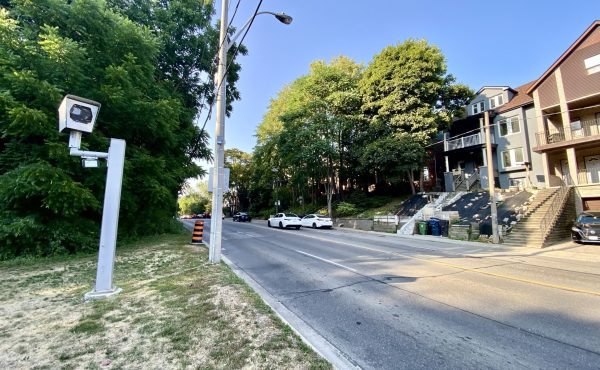
The City of Toronto released a report today from Toronto’s medical officer of health, Dr. David McKeown, that states nearly 200 lives a year and $1 billion in health costs could be saved if the city cut vehicle emissions by 30%. The report also estimates that costs associated with traffic pollution in the city are about $2.2 billion annually. You can also download the report from the City’s web site.
From the Saturday Star:
The report uses a Health Canada computer-based method called the Air Quality Benefits Tool to calculate the “burden of illness” and economic impact from traffic-related smog.
Authored by Dr. David McKeown, Toronto’s medical officer of health, the study claims this pollution contributes to about 440 premature deaths and 1,700 hospitalizations a year in Toronto.
While most cases involve the elderly, the pollution is also significantly affecting children, the report says, adding they experience 1,200 acute bronchitis episodes a year as a result, and 68,000 instances of asthma-related symptoms.
…
The report says pollution from traffic leads to about 200,000 restricted-activity days per year, where people spend the day sick in bed, or curtail their usual activities.
It also points to an “increasing body of literature” suggesting links between vehicle emissions and cancer, including a 2006 study from Europe of 4,000 people that concluded living close to roads with heavy traffic increased their risk of lung cancer.
Tracking traffic trends, the Toronto public health report says the number of vehicles leaving and entering the city each morning has increased by about 75 per cent over the past 20 years.
Last year, 67 per cent of trips into the city were made by vehicles with single occupants. Only about 20 per cent were made by public transit.
photo by Gary J. Wood




12 comments
I think the interesting bit is that McKeown not only says that cutting motor vehicle traffic by 30% would be good for your health, but that it is doable and he even goes on to suggest how. Table 8 (p. 33) in the background report (link in Matt’s post above) has lots of interesting ideas, but it also makes clear that sticking with the non-controversial stuff like HOV lanes doesn’t get you very far.
Where I think he really hits the nail on the head is when he talks about how we’ll never get more people to cycle, walk or take transit without making these options safer and more convenient – and that means taking the streets back from cars physically and budgetarily.
Pulling that trick off (or any of the other seriously effective options like pay-as-you-drive pricing, fuel taxes, limits on sprawl or better transit) will take a lot of political courage and that’ll only materialize and stay if we’re prepared to get vocal in our support.
This report is the pre-cursor for tolls.Toronto environmental alliance had a walk during the election and who showed up?I’ll let you guess on that one.Clue:ask Dave Meslin
The most effective way of achieving the 30% reduction goal would be to take the 1 or 2% of the oldest cars off the roads, which contribute, by far, the most to air pollution from cars. Also, I don’t see any discussion bout the opportunities offered by telecommuting. It does look like the results of this study have simply been extrapolated into a moral crusade against driving in general, which obscures what some of the most realistic and effective solutions might be.
Here are some suggestions to improving this situation.
1. Improve the job climate in the city.
Toronto has lagged the province and nearly the whole country for a fair length of time in creating jobs. In fact, the city has been moving in the opposite direction to the surrounding regions. Losing jobs while they have been gaining them. The closer people are to their place of employment the more likelihood that they will use public transit.
2. Provide incentives to remove older more polluting vehicles form the road. Newer cars are far cleaner than those from 10 or years ago. Surprisingly this is even more so for motorcycles and scooters (2 stroke). While they produce less carbon dioxide, they produce way more pollutants than cars.
3. The city core needs to have a ‘no fare’ public transit loop(s). I say ‘no fare’ because nothing is free and it will need to be subsidised. The cost for this should be paid from an additional property tax surcharge for those in the vicinity.
Tom B: do 1% – 2% of the cars on the road really produce 30% of the emissions? This would mean that there are cars on the road emitting over 20 times what the other ones are. I don’t believe such vehicles exist, but I could be wrong.
Maybe you just meant that this would be a good step in the right direction.
This is not a moral crusade. If anything, it is logically motivated movement, but it is more just a discussion about some interesting data.
A great deal of the pollution comes from the core states south of the border.A large part of south western ontario is effected by this smog.So even if you eliminated all the vehicles we would still have a problem with those particulates.However we need politicians with vision to plan a great system in toronto for public transit.Once that is done people will use the system, at the moment there is little incentive to take the ttc.Eliminating old vehicles doesn’t do anything, these vehicles are subject to testing every second plate renewal.It is the use of vehicle travel that makes that difference.And commercial vehicles by far contribute the most, next to gridlock, the longer a vehicle sits in traffic the worse it is for contributing to smog.
There are 10 year old cars like my Civic that are in mint condition and pass the Drive Clean level by a large margin. Then I see cars that I have no idea how they can pass Drive Clean or a safety inspection. This is an area that really needs review.
Interesting picture of traffic eh? Right beside a subway – too bad I don’t have the skills to show what a bike lane would look like along here – but maybe one can imagine it oneself!
The sad part about riding a bike beside this traffic is the CO that u get to be exposed to so close to the vehicle emmisions.But I think thee picture of the railway overpass is a good one what ever happened to those seemingly unused corridors that run through our city.They used to be needed when manufacturing was part of this city.But now we need them for inter city people transportation.So which politician has the guts to take on the railway owners??
Looking over the recommendations for combating the problem, I’m not sure Dr. McKeown is being very realistic.
It’s great to speak about designing cities around people and not cars, but the suburbs are there – they’re not going to disappear or be remade over night. People are moving to Guelph or Hamilton for lower housing costs, so we have to productively deal with our urban layout as it’s currently designed.
The big stat here is the 67% single occupancy vehicles. Assuming that a vehicle can carry four people, packing in a car with four people could reduce the number of cars entering by four times. That’s like going from 67,000 cars to 16,750.
Providing incentives for maxed out carpooling has to be the target – and this is something that be done without putting in tolls or reducing the number of people coming into the city. Everyone can benefit from this – shorter commutes, less traffic, less smog – if we stay away from toll discussions it might be possible to generate enough political will to make a dent in the problem.
We sold our car three years ago (it failed the emissions test). I bussed it to work for two years (much less stressful and almost as fast as driving). Now I bike to work. I am fitter, happier, and I save about $600.00 dollars a month. I feel sorry for car owners in Toronto. It is a horrible lifestyle: you pay about four different institutions and are subject to every inflationary hike imaginable. Cars are dangerous, filthy, expensive, space-consuming and pretty ugly. Yet they have never been safer, cleaner, healthier, more efficient or more attractive in our history. I hope our addiction to gas powered domestic vehicles ends soon. I guess the only way is for every driver to realize how much wealthier, healthier and happier s/he would be by taking their bike. (P.S.: We have three kids and we bike every where).
There is one way to cut emissions by over 90% right now. GESI represents a technological breakthrough in catalytic conversion systems. Visit http://www.gesi.ca or email me and I would be happy to arrange a demonstration or provide references. Gesi also works on propane lift trucks, buses, trucks, lawn mowers, zambonis, ice edgers… athan@gesi.us